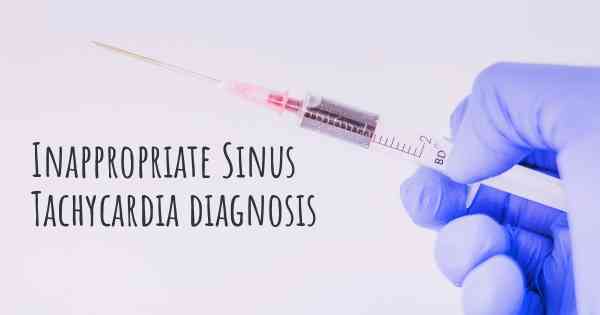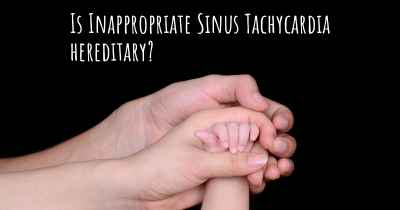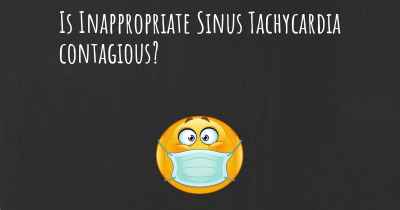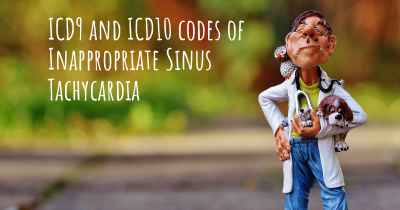How is Inappropriate Sinus Tachycardia diagnosed?
See how Inappropriate Sinus Tachycardia is diagnosed. Which specialists are essential to meet, what tests are needed and other useful information for the diagnosis of Inappropriate Sinus Tachycardia

Diagnosis of Inappropriate Sinus Tachycardia
Inappropriate Sinus Tachycardia (IST) is a condition characterized by an abnormally fast heart rate at rest, which is not proportional to the level of physical activity or stress. It is important to diagnose IST accurately to ensure appropriate management and treatment. The diagnosis of IST involves a comprehensive evaluation of the patient's medical history, physical examination, and various diagnostic tests.
Medical History
The first step in diagnosing IST is obtaining a detailed medical history from the patient. The healthcare provider will ask about the patient's symptoms, including palpitations, rapid heartbeat, dizziness, shortness of breath, and fatigue. They will also inquire about any underlying medical conditions, such as thyroid disorders, autonomic dysfunction, or previous heart problems. Additionally, the healthcare provider will assess the patient's medication history, as certain drugs can contribute to the development of IST.
Physical Examination
During the physical examination, the healthcare provider will assess the patient's vital signs, including heart rate, blood pressure, and respiratory rate. They will listen to the patient's heart sounds using a stethoscope to detect any abnormal rhythms or murmurs. The provider will also perform a thorough examination of other body systems to rule out any underlying causes of tachycardia.
Electrocardiogram (ECG)
An electrocardiogram (ECG) is a non-invasive test that records the electrical activity of the heart. It is a crucial tool in diagnosing IST. During an ECG, electrodes are placed on the patient's chest, arms, and legs to measure the electrical signals produced by the heart. The ECG can reveal abnormalities in the heart's rhythm and rate, helping to differentiate IST from other types of tachycardia.
If the patient's heart rate exceeds 100 beats per minute at rest and there are no apparent causes for the increased heart rate, it may indicate IST. However, it is important to note that other conditions, such as atrial fibrillation or supraventricular tachycardia, can also present with a rapid heart rate, so further tests may be necessary to confirm the diagnosis.
Exercise Stress Test
An exercise stress test, also known as a treadmill test, is often performed to evaluate the heart's response to physical activity. During this test, the patient walks on a treadmill or pedals a stationary bicycle while connected to an ECG machine. The healthcare provider monitors the patient's heart rate, blood pressure, and ECG readings during exercise. In patients with IST, the heart rate may increase excessively and disproportionately to the level of exertion.
24-Hour Holter Monitoring
A 24-hour Holter monitor is a portable device that records the heart's electrical activity continuously over a 24-hour period. The patient wears electrodes attached to their chest, and the device records the ECG readings throughout the day and night. This test is particularly useful in capturing episodes of tachycardia that may occur sporadically. The recorded data is then analyzed by a healthcare professional to identify any abnormal heart rhythms or patterns associated with IST.
Echocardiogram
An echocardiogram is a non-invasive imaging test that uses sound waves to create a detailed picture of the heart's structure and function. It provides valuable information about the heart's chambers, valves, and overall pumping ability. An echocardiogram can help identify any structural abnormalities or underlying heart conditions that may be contributing to the development of IST.
Blood Tests
Blood tests may be ordered to assess the patient's thyroid function, electrolyte levels, and other parameters that can affect heart rate and rhythm. Thyroid disorders, such as hyperthyroidism, can cause tachycardia and may need to be ruled out as a potential cause of IST.
Additional Tests
In some cases, additional tests may be required to exclude other potential causes of tachycardia or to evaluate autonomic function. These tests may include tilt table testing, which assesses the body's response to changes in position, or autonomic function tests that measure the autonomic nervous system's control over heart rate and blood pressure.
It is important to consult with a healthcare professional for an accurate diagnosis of Inappropriate Sinus Tachycardia. The combination of medical history, physical examination, and various diagnostic tests helps to differentiate IST from other types of tachycardia and identify any underlying causes or contributing factors.
Posted May 9, 2017 by Jae 1050
Posted Sep 4, 2017 by Liette 1500
Posted Sep 9, 2017 by Sheri 700
Posted Sep 21, 2017 by Matthew_94 3340
Posted Mar 28, 2018 by Mel 2300
Posted May 22, 2018 by Sara 2550








